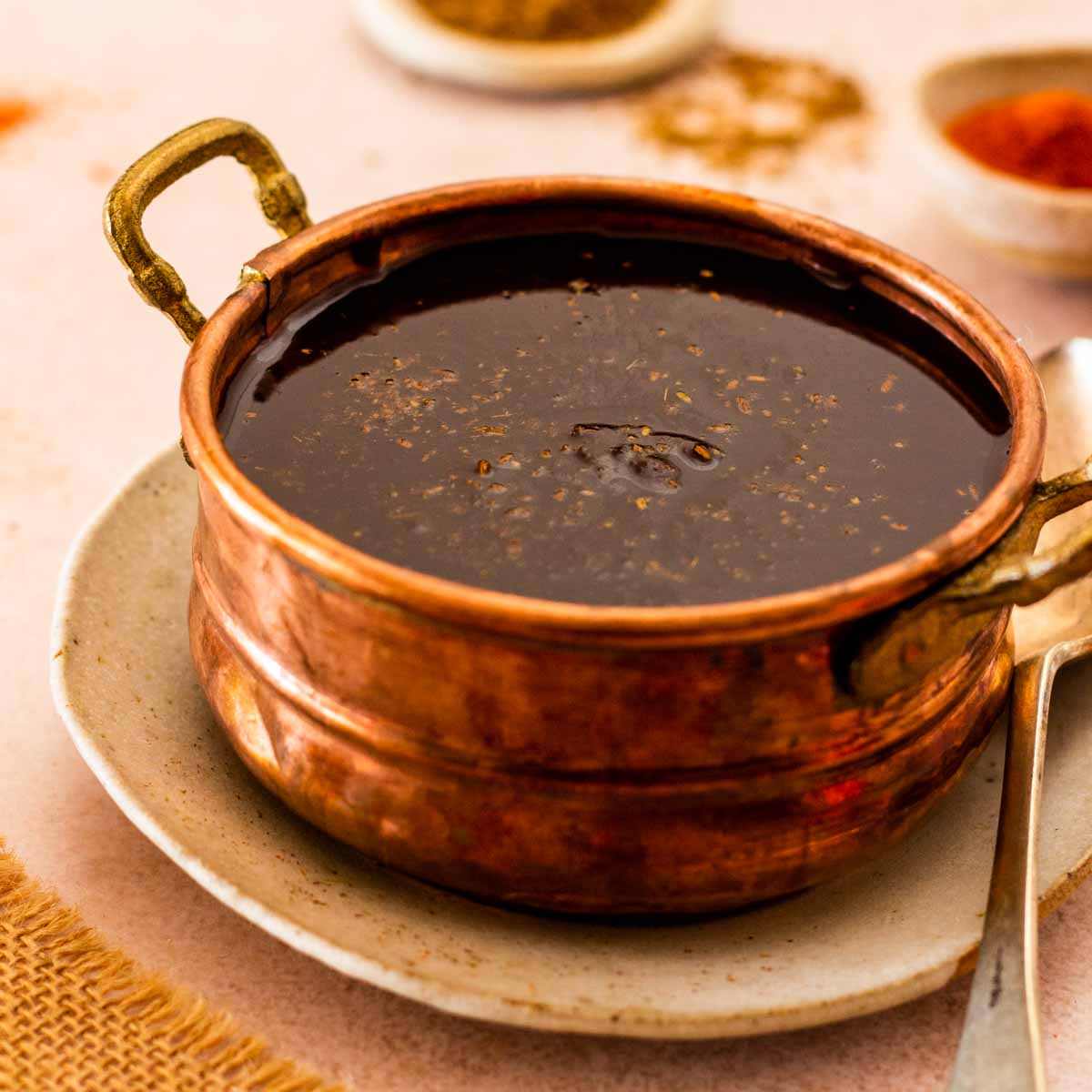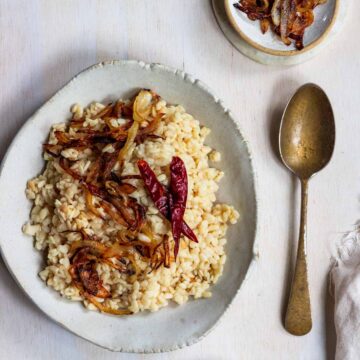Learn how to make sweet and tangy Imli Chutney – an essential condiment for chaat and Pakistani / Indian snacks. This is a quick and easy version made with just 5 ingredients – imli / tamarind pulp, sugar and spices. There are no dates (khajoor) or jaggery (gurr) used in this recipe. It’s the perfect balance of sweetness, tanginess, with a hint of spice.

Imli Chutney (also known as Tamarind Chutney) is one of my favourite Pakistani condiments. It’s often called meethi chutney as well, with meethi meaning sugar. There’s always a jar of it in the fridge. In fact, I make a big batch every Ramadan, giving out bottles to friends as well. It’s an essential ingredient in chaat, be it chana chaat (chickpea chaat) or dahi baray to provide a burst of sweet tanginess. It’s a versatile dip to have on the side with keema samosa and pakoras.
Why this recipe works
- Balance of Flavours: It’s got the perfect balance of flavours. There’s sweetness from the sugar, tanginess from the tamarind, with a hint of spice to bring it all together.
- Versatility: This chutney works with all dishes. Whether it’s street food such as aloo chana chaat, snacks such as chicken pakora and paneer samosas, or BBQ such as chicken malai boti.
- Make-Ahead Preparation: This chutney can be made in bulk, and kept in the refrigerator for weeks, or in the freezer for months. It’s also a great gift for friends and family for Ramadan.
- Uses 5 ingredients only: This recipe is made using 5 ingredients only. No dates or gurr (jaggery) required for this recipe. The only ingredient that is uncommon is the tamarind pulp, which is easily available at Indian, Pakistani or Asian stores or in the international aisle of large supermarkets.
Ingredients
This recipe uses just 5 ingredients! The last 2 ingredients are optional, and can be skipped if you don’t want to add them.

- Tamarind Pulp – The main ingredient in this recipe is tamarind pulp / imli pulp. This is available in big, dark amber-coloured blocks in Pakistani / Indian stores, as well as Asian stores along with the international aisle of major supermarkets. The pulp is made from the fleshy membrane that surrounds the tamarind seed pod, which gets compacted into a brick form. It is available both seedless, and with seeds. Seedless is easier to use, as it requires less straining.
- Sugar – regular castor sugar. You can always add more or less, depending on whether you prefer a sweeter or tangier chutney. Can be substituted with brown sugar as well.
- Red Chilli Powder – added for a little heat.
- Salt – any type of salt can be used.
- Roasted & Ground Cumin Seeds (Bhuna Zeera) – this is added for it’s savoury earthy flavour, and to balance out the sweetness. I always have a jar of this in my pantry because of how often I use it. To make your own, follow my recipe for bhuna zeera here.
- Vinegar – this is an optional ingredient, but I always add it as it acts as a natural preservative and increases the shelf life. You may need to add a teaspoon or two of sugar to balance out the vinegar.
- Ginger powder – also known as saunth, this is also added for it’s earthy gingery flavour. Can be skipped if not available.
Method
Making Imli Chutney (Tamarind Chutney) is very easy. Plus you can easily make a big batch, and store it in the fridge or freezer to last for a long time.

Soaking the tamarind pulp: Place the tamarind pulp in a large bowl, and then add warm water on top. Soak for 30 minutes to an hour, till the tamarind loosens up and starts separating. If you are making a big batch, you might need to soak for longer.

Strain the tamarind pulp: Use a strainer / colander to strain the fibre and seeds (if using seedless pulp) soaked tamarind pulp. You can use a spoon or your hands to help in pushing the tamarind pulp through. In case the pulp is difficult to strain, add more hot water.

Cook the tamarind pulp: Place the strained tamarind pulp into a saucepan, and bring to a boil. Add sugar, salt, and red chili powder. Cook till the tamarind pulp thickens into a sauce like consistency.

Finish cooking: Once the imli chutney has cooked to your desired consistency, taste and adjust seasonings if required. Remove from heat, and then add roasted cumin seeds. Add vinegar and ginger powder (if using) at this stage.
Storage Instructions
Once the imli chutney is cool, transfer to a clean moisture free airtight plastic or glass container and store in the refrigerator. If making chutney in bulk, it’s best to use multiple containers, taking one out as needed. Make sure to use a clean moisture free spoon when serving the chutney, otherwise it may spoil.
Imli chutney can be kept in the refrigerator for 2 months easily, even longer. However, make sure to add vinegar if storing for longer than 2 – 3 weeks. The vinegar acts as a preservative to improve shelf life.
It can also be frozen – again best to store in smaller containers, and take out one container as needed.

Serving Suggestions
Imli chutney is usually served as a condiment with Pakistani / Indian snacks such as aloo kebabs, samosas and pakoras. It is also an essential ingredient in all types of chaat, be it chana chaat, dahi baray chaat, or samosa chaat. It’s also a delicious condiment next to dry BBQ items such as chicken tikka, malai boti, or beef boti.

FAQs
Imli chutney from scratch is best made from a block of tamarind pulp – the pulp has that signature tamarind tartness in its fresh, raw form. Whereas the other forms of tamarind can often be either too sweet or too tart to balance out properly. The concentrate, paste and puree are great in recipes where you need a few tablespoons of tamarind, and can’t be bothered to rehydrate it from a block. However, I’d not recommend using it to make chutney.
To thicken the imli chutney, reduce the amount of water used for straining. Or simmer the chutney for a longer time on low-medium heat. Remember, the chutney will thicken after cooling. In case it still doesn’t thicken, you can add cornflour mixed in vinegar and let it cook till it thickens.
Recipes to enjoy with Imli Chutney

📖 Recipe
Imli Chutney w/o Dates (Tamarind Chutney)
Ingredients
- 1 cups (250g) seedless tamarind pulp
- 1 cup (200g) sugar
- 1 teaspoon salt to taste
- 1 teaspoon red chili powder to taste
- 1 teaspoon roasted cumin seeds (bhuna zeera)
- ½ teaspoon ginger powder optional
- 1 tablespoon vinegar optional
Instructions
- Break the block of tamarind pulp into small chunks, and place in a medium sized bowl. Pour enough hot water to cover the tamarind pulp and let sit for around 15 - 20 minutes.
- Take a large bowl, and place a colander on top of it. Strain the tamarind pulp through. Use your hands or the back of a spoon to help in straining the soaked tamarind through. This step can be messy but it’s essential to ensure that all the delicious tamarind pulp is squeezed through without the skin and seeds. If the tamarind pulp is difficult to push through, use more hot water.
- Place the strained tamarind pulp in a small sauce-pan, and bring to a boil on low-medium heat. Add sugar, salt and red chili powder. Keep on low heat, while heating, till the tamarind pulp thickens into a sauce like consistency. This will take about 20 - 30 minutes.
- Take off heat, and add roasted cumin seeds (bhuna zeera) and ginger powder (if using). Vinegar can be added as a preservative at this stage, if using.
- Let the tamarind chutney cool - it will thicken more upon cooling. Pour into an air-tight bottle. Refrigerate and serve as needed.
Notes
- Store the tamarind chutney in a clean moisture free airtight plastic or glass container in the refrigerator. If making chutney in bulk, it’s best to use multiple containers, taking one out as needed.
- Make sure to use a clean moisture free spoon when serving the chutney, otherwise it may spoil.
- Imli chutney can be kept in the refrigerator for 2 months easily with the addition of vinegar as a preservative.
- It can also be frozen – again best to store in smaller containers, and take out one container as needed.











Tomdaya says
Same as my mother's recipe 😋 🤗 ☺️
Maham Ehab says
Perfect for dahi bharay, chana chaat and even bun kebabs!
Shameen says
Nice work
Tasmiyah says
Uff! This is such a staple every Ramzaan! Thanks for sharing the recipe 🙂